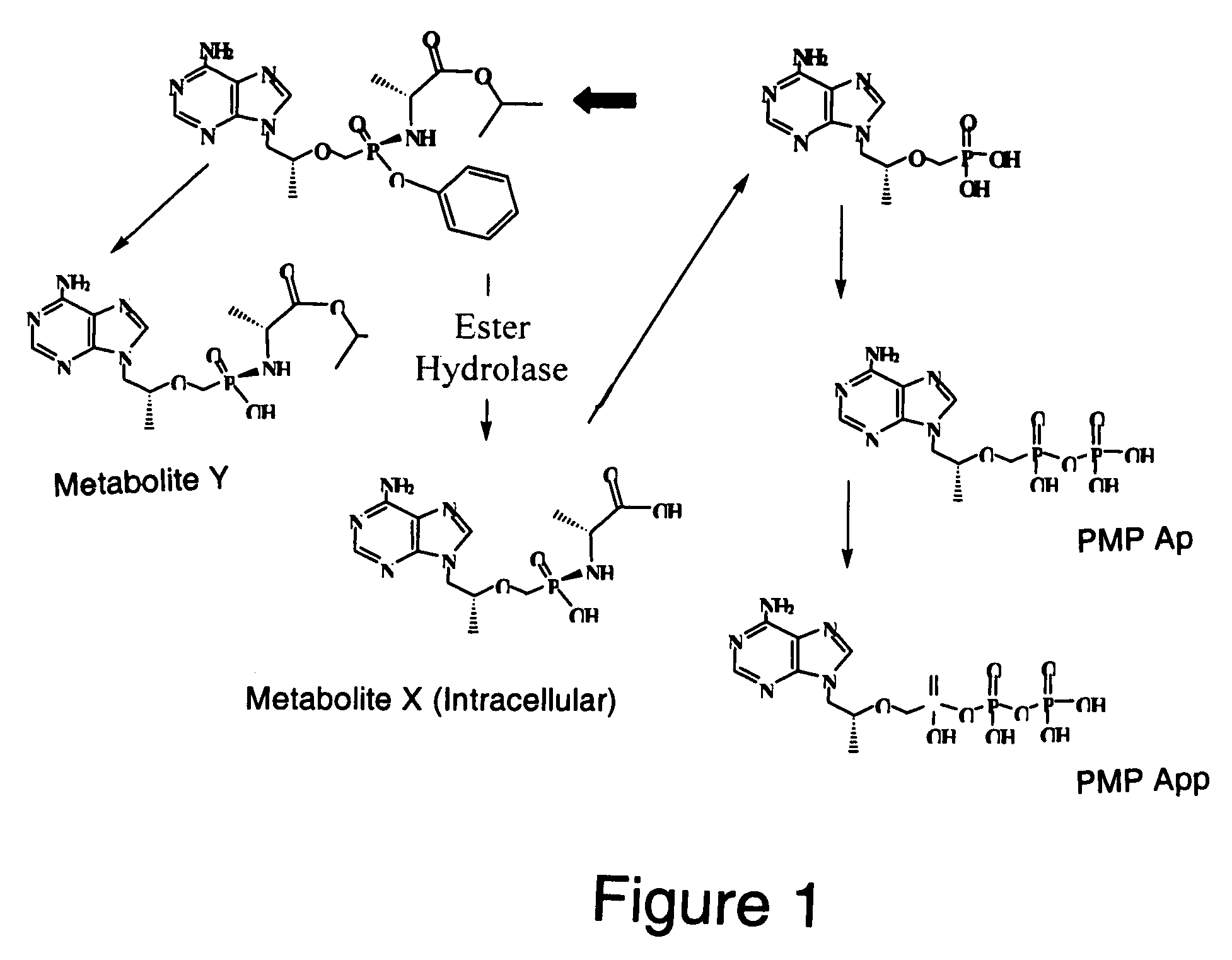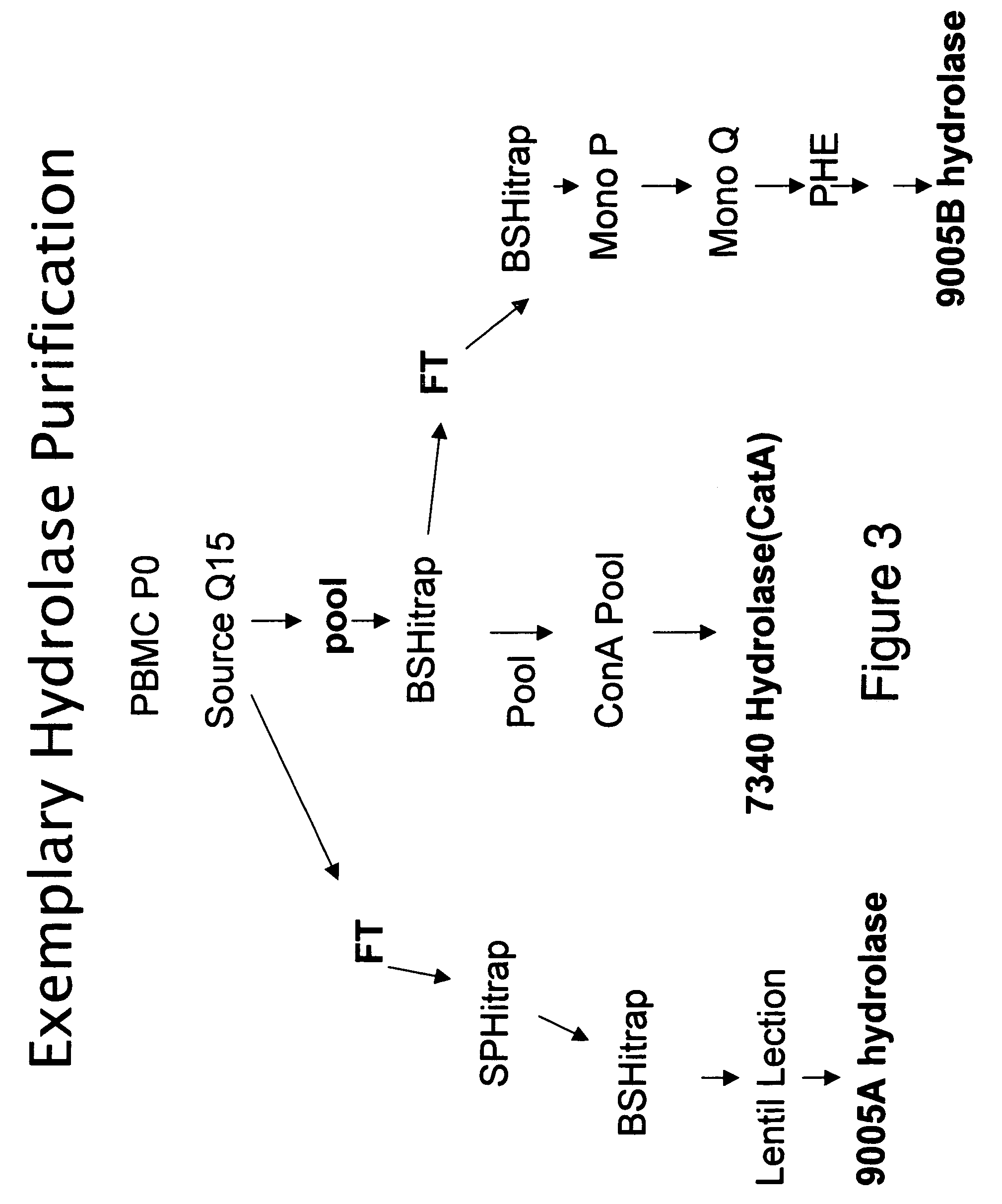Methods and compositions for identifying therapeutic compounds with GS-9005 ester hydrolase B
a technology of ester hydrolase and compound, which is applied in the field of methods and compositions for identifying therapeutic compounds with gs-9005 ester hydrolase b, can solve the problems of difficult or inefficient intracellular target, difficult to minimize intercellular redistribution of drugs, and many attempts to develop effective methods, etc., to achieve the effect of determining the intracellular persistence of candidate compounds
- Summary
- Abstract
- Description
- Claims
- Application Information
AI Technical Summary
Problems solved by technology
Method used
Image
Examples
example 1
Metabolism of Nucleotide Phosphoramidates
[0143]The efficient conversion of Compound L (Table 1) to its intracellular depot forms, cMetabolite (cMet) and Metabolite X′ (MetX), occurs via hydrolysis of the ethoxyl ester of Compound L (FIG. 2). A nucleophilic attack by the oxygen of the phenyl ester results in the formation of a 5-membered cyclic intermediate A. Intermediate A undergoes tranformation by two alternative pathways to intercellular depot forms, cMetabolite and Metabolite X′. In one pathway, the intermediate A is believed to undergo an intramolecular rearrangement involving the 5-membered ring to form cMet. In another pathway, the 5-membered ring of intermediate A is opened by the addition of water to form MetX′. cMetabolite and Metabolite X′ may accumulate in cells, such as peripheral blood mononuclear cells (PBMCs) for example. Cellular accumulation of cMet and MetX′ can be measured as in Examples 2A and 2B. In the case of other drug scaffolds with phosphonate prodrug moi...
example 2
Ester Hydrolase Assay
[0144]A. Rate of Production of [14C] cMetabolite plus [14C] Metabolite X′:
[0145]The enzymatic production of cMetabolite (cMet) and Metabolite X′ (Met X′) from the Compound L is monitored using the following ester hydrolase assay. Varying amounts of peripheral blood mononuclear cell (PBMC) extracts, column fractions or pools are incubated with [14C] Compound L at 37° C. for 10-90 min. The production of [14C] cMetabolite and [14C] Metabolite X′ is monitored by measuring the amount of radioactivity retained on an anion exchange resin (DE-81). High performance liquid chromatography (HPLC) and mass spectrometry (MS) analysis of the reaction mixture and radioactivity retained on the filter confirm that only [14C]-cMetabolite and [14C]-Metabolite X′ bind the DE-81 filter. Under the assay conditions, the more hydrophobic [14C] Compound L is not retained on the DE-81 membrane. The final reaction conditions are 25 mM 2-[N-morpholino]ethanesulfonic acid (MES), pH 6.5, 100 ...
example 3
Non-Specific Esterase Assay
[0148]Non-specific ester hydrolase activity is monitored by monitoring the enzymatic cleavage of alpha napthyl acetate (ANA) (Mastropaolo and Yourno, Anal. Biochem. 115:188-193 (1981)). This substrate has been used for both the measurement of esterase enzyme activity and in situ staining of esterases in tissue samples (Yourno and Mastropaolo, Blood 58:939-946 (1981); Yourno et al., Blood 60:24-29 (1982); Yourno et al., J. Histochem. Cytochem. 34:727-733 (1986)). The method described is a modification of the assay described by Mattes and Mattes, Toxicol. Appl. Pharmacol. 114: 71-76 (1992). Varying amounts of peripheral blood mononuclear cell (PBMC) extracts, column fractions, or pools are incubated with ANA at 37° C. for 20 min. The final reaction conditions are: 10 mM sodium phosphate, pH 6.5, 97 μM ANA and varying amounts of GS-9005 ester hydrolase B in a final volume of 150 μl. The reaction mixture is incubated at 37° C. for 20 minutes, and the reaction ...
PUM
| Property | Measurement | Unit |
|---|---|---|
| molecular weight | aaaaa | aaaaa |
| molecular weight | aaaaa | aaaaa |
| molecular weight | aaaaa | aaaaa |
Abstract
Description
Claims
Application Information
 Login to View More
Login to View More - R&D
- Intellectual Property
- Life Sciences
- Materials
- Tech Scout
- Unparalleled Data Quality
- Higher Quality Content
- 60% Fewer Hallucinations
Browse by: Latest US Patents, China's latest patents, Technical Efficacy Thesaurus, Application Domain, Technology Topic, Popular Technical Reports.
© 2025 PatSnap. All rights reserved.Legal|Privacy policy|Modern Slavery Act Transparency Statement|Sitemap|About US| Contact US: help@patsnap.com



